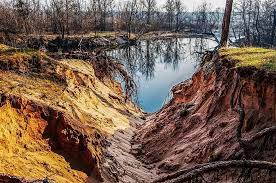WE are aware that soil erosion is one of the environmental challenges that has greatly degraded
the environment as confirmed 76 tonnes of soils are lost per hectare in a year due to soil erosion.
Soils being eroded have led to the formation of gullies, as we are in the rainy season, the season
of gullies due to rains falling on uncovered soils forming streams that wash away top soils and
form furrows, which mature to gullies/dongas/makoronga if they are not controlled. Gullies are
permanent erosion forms that develop especially in arid and semi-arid environments
Human land use, and especially changes in land use and remodelling of terrain, may accelerate
gully expansion by head cutting, sidewall collapse, piping, floor erosion, and other processes,
which lead to widespread land degradation and potential damage to human structures and
activities. Deforestation also contributes to gully formation as vegetation is cleared and leaving
the soil bare. This promotes the rate of surface run-off and erosion and lowers the rate of
infiltration as there is no vegetation to bind soil and small trenches begin to form.
Uncontrolled veld fires remove the vegetation and leave the ground unprotected, and thus
increase surface run-off and forms gullies.
Overgrazing also contributes to gully formation whereby ground cover that protects the soil is
removed resulting in gully erosion.
Gullies can also be formed depending on the type of soil. Saline soils are easily eroded and cause
gullies. Climate is also a major factor that contributes to gully formation. Areas that receive low
rainfall have sparse ground cover and thus make gully erosion.
Gullies have the following effects:
Gully erosion brings about reduction of arable farmland; it also reduces the quality of crops
grown on such areas which may later lead to decrease in agricultural productivity and food
shortage thus, resulting in famine.
Continuous gully erosion will eventually lead to loss of nutrients and organic matter which will
eventually prevent plants from surviving in the affected areas.
Pollution of ecosystem: the materials that are washed away from farms and fields usually settle
somewhere, and one of such places is in streams, rivers or on an empty land. Soil washed into a
river can alter the natural course of the waterway, change the natural colour of water, changing
its depth and even forcing the water into a new path over time. Worse of all, much of the topsoil
that is washed away from agricultural operations is rich in nitrogen-based fertilizers, this can
combine with other nutrients in the water to support algae blooms.
Gully erosion has resulted in loss of vegetation as its continuous expansion encroaches into the
natural forest; this is mostly caused by high land demand by increasing population, which
eventually leads to falling of trees for construction as a result of this, the surface of the soil is
continuously exposed to gully erosion.
Gully erosion has effect on human life as many lives have been lost as a result of the problem of
gully erosion. Some people have sometime fallen into these gullies and get injured or died. Some
have also been reported where people are drowned in some of the gully sites.
Alternatives/control measures
-Plant cover crops to reduce surface run off and soil loss.
-Areas that experiences gully erosion are advised to construct check dams across the gully bed to
stop channel and lateral erosion and stones should be laid across the gully area to form a gradual
slope to the downstream side of the dam.
-Brush check dams can be built across the gully by driving wooden pegs into the ground and
then intertwining bush-wood along the pegs, by doing this, silt will be trapped behind the dam.
-In areas with high slope and heavy rainfall, a stronger structure may be necessary. Gabions are
wire woven baskets filled with stones, and can be placed across the gully area.
-Land use can be changed into a different use, especially in certain areas experiencing gully
erosion. For instance, if the land was initially used for grazing, it should be allowed to revert to
native vegetation to allow organic matter to build up. In other cases, it may be necessary to stop
any further cultivation and keep the areas only for a longer period to retain back its natural state.
-Divert flowing water away from erosion prone areas by constructing runoff pipes to channel
and reduce the force of running water to elsewhere.
-Trees should be planted in strips across the gully sites to reduce the velocity of water, trap silt,
and to prevent further erosion from occurring.



